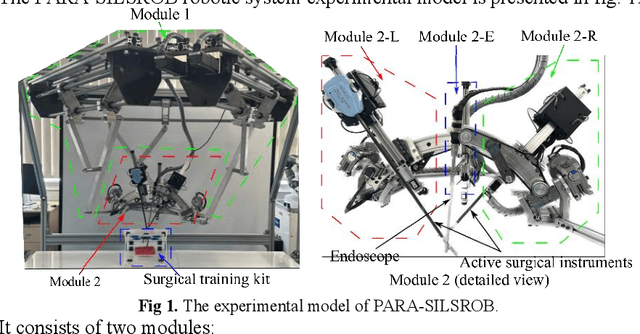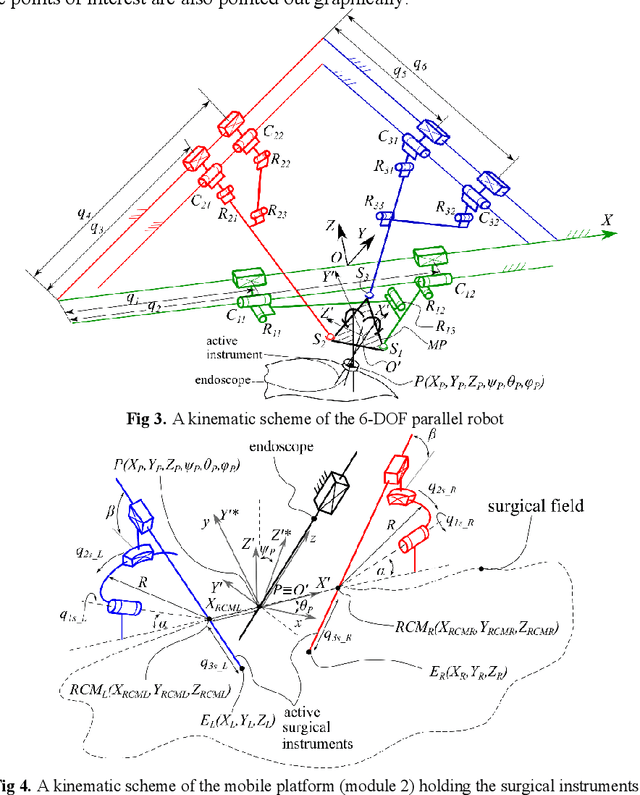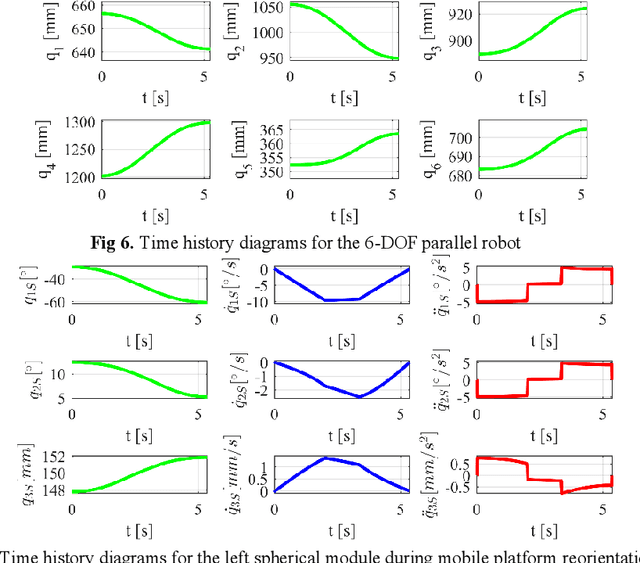Damien Chablat
LS2N - équipe RoMas, LS2N
A Novel Skill Modeling Approach: Integrating Vergnaud's Scheme with Cognitive Architectures
Sep 16, 2025Abstract:Human-machine interaction is increasingly important in industry, and this trend will only intensify with the rise of Industry 5.0. Human operators have skills that need to be adapted when using machines to achieve the best results. It is crucial to highlight the operator's skills and understand how they use and adapt them [18]. A rigorous description of these skills is necessary to compare performance with and without robot assistance. Predicate logic, used by Vergnaud within Piaget's scheme concept, offers a promising approach. However, this theory doesn't account for cognitive system constraints, such as the timing of actions, the limitation of cognitive resources, the parallelization of tasks, or the activation of automatic gestures contrary to optimal knowledge. Integrating these constraints is essential for representing agent skills understanding skill transfer between biological and mechanical structures. Cognitive architectures models [2] address these needs by describing cognitive structure and can be combined with the scheme for mutual benefit. Welding provides a relevant case study, as it highlights the challenges faced by operators, even highly skilled ones. Welding's complexity stems from the need for constant skill adaptation to variable parameters like part position and process. This adaptation is crucial, as weld quality, a key factor, is only assessed afterward via destructive testing. Thus, the welder is confronted with a complex perception-decision-action cycle, where the evaluation of the impact of his actions is delayed and where errors are definitive. This dynamic underscores the importance of understanding and modeling the skills of operators.
Design of an innovative robotic surgical instrument for circular stapling
Jun 11, 2025Abstract:Esophageal cancer remains a highly aggressive malignancy with low survival rates, requiring advanced surgical interventions like esophagectomy. Traditional manual techniques, including circular staplers, face challenges such as limited precision, prolonged recovery times, and complications like leaks and tissue misalignment. This paper presents a novel robotic circular stapler designed to enhance the dexterity in confined spaces, improve tissue alignment, and reduce post-operative risks. Integrated with a cognitive robot that serves as a surgeon's assistant, the surgical stapler uses three actuators to perform anvil motion, cutter/stapler motion and allows a 75-degree bending of the cartridge (distal tip). Kinematic analysis is used to compute the stapler tip's position, ensuring synchronization with a robotic system.
A Pillbug-Inspired Morphing Mechanism Covered with Sliding Shells
Jun 05, 2025Abstract:This research proposes a novel morphing structure with shells inspired by the movement of pillbugs. Instead of the pillbug body, a loopcoupled mechanism based on slider-crank mechanisms is utilized to achieve the rolling up and spreading motion. This mechanism precisely imitates three distinct curves that mimic the shape morphing of a pillbug. To decrease the degree-of-freedom (DOF) of the mechanism to one, scissor mechanisms are added. 3D curved shells are then attached to the tracer points of the morphing mechanism to safeguard it from attacks while allowing it to roll. Through type and dimensional synthesis, a complete system that includes shells and an underlying morphing mechanism is developed. A 3D model is created and tested to demonstrate the proposed system's shape-changing capability. Lastly, a robot with two modes is developed based on the proposed mechanism, which can curl up to roll down hills and can spread to move in a straight line via wheels.
An analysis of higher-order kinematics formalisms for an innovative surgical parallel robot
Mar 27, 2025Abstract:The paper presents a novel modular hybrid parallel robot for pancreatic surgery and its higher-order kinematics derived based on various formalisms. The classical vector, homogeneous transformation matrices and dual quaternion approaches are studied for the kinematic functions using both classical differentiation and multidual algebra. The algorithms for inverse kinematics for all three studied formalisms are presented for both differentiation and multidual algebra approaches. Furthermore, these algorithms are compared based on numerical stability, execution times and number and type of mathematical functions and operators contained in each algorithm. A statistical analysis shows that there is significant improvement in execution time for the algorithms implemented using multidual algebra, while the numerical stability is appropriate for all algorithms derived based on differentiation and multidual algebra. While the implementation of the kinematic algorithms using multidual algebra shows positive results when benchmarked on a standard PC, further work is required to evaluate the multidual algorithms on hardware/software used for the modular parallel robot command and control.
An innovative mixed reality approach for Robotics Surgery
Jan 07, 2025Abstract:Robotic-assisted procedures offer numerous advantages over traditional approaches, including improved dexterity, reduced fatigue, minimized trauma, and superior outcomes. However, the main challenge of these systems remains the poor visualization and perception of the surgical field. The goal of this paper is to provide an innovative approach concerning an application able to improve the surgical procedures offering assistance in both preplanning and intraoperative steps of the surgery. The system has been designed to offer a better understanding of the patient through techniques that provide medical images visualization, 3D anatomical structures perception and robotic planning. The application was designed to be intuitive and user friendly, providing an augmented reality experience through the Hololens 2 device. It was tested in laboratory conditions, yielding positive results.
Enhancing Otological Surgery: Co-Designing a Parallel Robot with Surgeon Input
Aug 06, 2024Abstract:This work presents the development of a parallel manipulator used for otological surgery from the perspective of co-design. Co-design refers to the simultaneous involvement of the end-users (surgeons), stakeholders (designers, ergonomic experts, manufacturers), and experts from the fields of optimization and mechanisms. The role of each member is discussed in detail and the interactions between the stakeholders are presented. Co-design facilitates a reduction in the parameter space considered during mechanism optimization, leading to a more efficient design process. Additionally, the co-design principles help avoid unforeseen errors and help in quicker adaptation of the proposed solution.
Continuous-Time Robust Control for Cancer Treatment Robots
Jul 23, 2024Abstract:The control system in surgical robots must ensure patient safety and real time control. As such, all the uncertainties which could appear should be considered into an extended model of the plant. After such an uncertain plant is formed, an adequate controller which ensures a minimum set of performances for each situation should be computed. As such, the continuous-time robust control paradigm is suitable for such scenarios. However, the problem is generally solved only for linear and time invariant plants. The main focus of the current paper is to include m-link serial surgical robots into Robust Control Framework by considering all nonlinearities as uncertainties. Moreover, the paper studies an incipient problem of numerical implementation of such control structures.
The control architecture of a spherical robot for Minimally Invasive Surgery
Jul 11, 2024Abstract:Control systems used in Minimally Invasive Surgery (MIS) play a crucial role in ensuring preci-sion and safety throughout procedures. This paper presents a control architecture developed for a robotic system designed for MIS operations. The modular structure of the control system allows for compatibility with a range of procedures in abdominal and thoracic regions. The proposed control system, employing the master-slave concept, is presented alongside the experimental model. Functional validation is obtained by performing a Siemens NX simulation and comparing the results with several experimental runs using the experimental model of the robot. With its compact size and stiffness, the system holds promise for integration with other robotic systems. Future efforts will be dedicated to exploring and optimizing this potential collaboration to enhance the overall capabilities of robotic-assisted surgery.
Comparison of robot morphologies and base positioning for welding applications
Jul 08, 2024Abstract:This article undertakes a comprehensive examination of two distinct robot morphologies: the PUMA-type arm (Programmable Universal Machine for Assembly) and the UR-type robot (Universal Robots). The primary aim of this comparative analysis is to assess their respective performances within the specialized domain of welding, focusing on predefined industrial application scenarios. These scenarios encompass a range of geometrical components earmarked for welding, along with specified welding paths, spatial constraints, and welding methodologies reflective of real-world scenarios encountered by manual welders. The case studies presented in this research serve as illustrative examples of Weez-U Welding practices, providing insights into the practical implications of employing different robot morphologies. Moreover, this study distinguishes between various base positions for the robot, thereby aiding welders in selecting the optimal base placement aligned with their specific welding objectives. By offering such insights, this research facilitates the selection of the most suitable architecture for this particular range of trajectories, thus optimizing welding efficiency and effectiveness. A departure from conventional methodologies, this study goes beyond merely considering singularities and also delves into the analysis of collisions between the robot and its environment, contingent upon the robot's posture. This holistic approach offers a more nuanced understanding of the challenges and considerations inherent in deploying robotic welding systems, providing valuable insights for practitioners and researchers alike in the field of robotic welding technology.
Kinematic analysis of a parallel robot for minimally invasive surgery
Jun 04, 2024



Abstract:The paper presents the kinematic modelling for the coupled motion of a 6-DOF surgical parallel robot PARA-SILSROB which guides a mobile platform carrying the surgical instruments, and the actuators of the sub-modules which hold these tools. To increase the surgical procedure safety, a closed form solution for the kinematic model is derived and then, the forward and inverse kinematic models for the mobile orientation platform are obtained. The kinematic models are used in numerical simulations for the reorientation of the endoscopic camera, which imposes an automated compensatory motion from the active instruments' mod-ules.
 Add to Chrome
Add to Chrome Add to Firefox
Add to Firefox Add to Edge
Add to Edge